
Wojciech Puś, The Endless Party, 2016, photo Jakub Ceran
Dobromiła Błaszczyk: I’d like to start our conversation with something that has preoccupied us over the last two months – the cover of the latest issue of our magazine, which you designed. On a mirror surface, it shows a slogan from another of your works, “Don’t Give Me Problems. Give Me Solutions.” On the one hand, that work is linked to the beginnings of your theatrical practice; on the other, it is connected with the way you work, with your thinking and searching for the best solution, the most suitable idiom and the best way to express yourself.
Wojciech Puś: Theater is a machine where there’s no time for complaining; you need to solve problems, find solutions, and do that while acting in various capacities. I’ve worked on numerous projects as a lighting director and stage designer. The director not only expects a visual contribution from the stage designer, but also treats him as someone to confide his problems in, as a buffer of the emotions that surround the project, and that, honestly speaking, is terribly hard to bear. But this ends when you start doing your own thing, when theater recedes into the background. The phrase on the cover of your magazine dates from a period when I was working with Mariusz Treliński, and he applied it to his co-workers. He didn’t want to be told about problems; he wanted solutions right away.
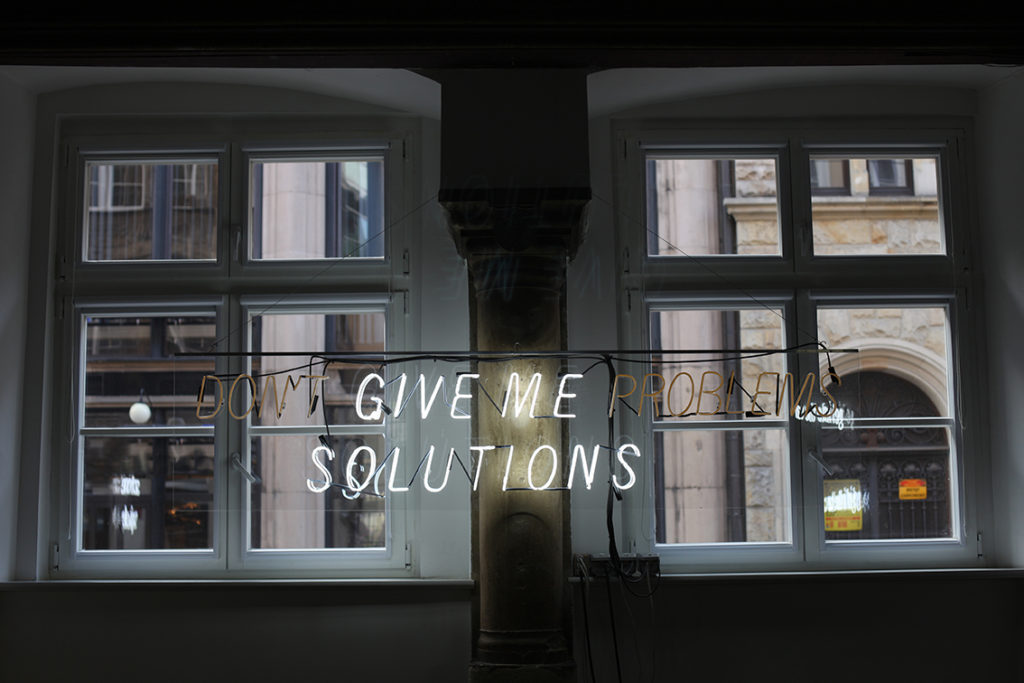
Wojciech Puś, Don’t Give Me Problems Give Me Solutions, neon

Wojciech Puś, Don’t Give Me Problems Give Me Solutions, neon
DB: You later used it in one of your neon signs.
WP: That’s right. I was wondering how to mediate corporate thinking and transpose it, in a condensed form, to the field of art. I guess many corporate employees have heard the words, “Don’t give me problems, give me solutions. Come on! You can do it!” Many people from outside the art world can relate to them. That neon sign was one in a larger series of such signs for the film Given, and it led eventually to a series of internet neon memes. One of those, OMGWTF, was shown in the exhibition Chamber of Light at the Muzeum Sztuki in Łódź, alongside the works of artists such as Anri Sala, Stefan and Franciszka Themerson, or Józef Robakowski. Those neon signs were meant as a reminder that structures, corporate hierarchies, are present in the art world too. In those years, such an approach corresponded with the critical path of post-Internet art, which today has become very trendy, has devoured itself – the whole immense plastic, aesthetic machine criticizing techno-capitalism, so clearly present at art fairs! I guess last year’s Berlin Biennale, subversively curated by DIS, was a kind of burial of that aesthetic.
DB: You’ve stopped working for theater for a while and have focused instead on your own projects, where you employ various means of expression. In this context, the slogan acquires a whole new significance.
WP: I finally solve my own problems, and I look at things from a completely different perspective, yeah…
DB: In your most recent project, the film Endless, you combine various disciplines. But such a strategy has been present throughout your work. No matter what medium you use, it isn’t an end unto itself; what matters is what you want to say through it. It is your own issues that you try to solve; those are highly intimate stories…
WP: What matters in the first place is not technology, you know – though, admittedly, it is fascinating and important too – but the story and the emotions that I try to convey. It seems to me that in every work there occurs a moment when the process becomes as important as the intended result. Endless is such a project. The story is based on the biography of a friend of mine who has undergone a sex change procedure. We’re in the process of stitching this material together with themes inspired by Alain Robbe-Grillet’s short story, Last Year at Marienbad, and by autobiographical fragments of Paul Preciado’s book, Testo Junkie: Sex, Drugs and Biopolitics in the Pharmacopornographic Era. We’ve done the first test shootings and more are ahead. The script should be ready by early 2017 and then we move into pre-production phase. Endless, which is an international project in terms of crew and locations, was developed under the tutelage of Vitakuben’s Leif Magne Tangen during my half-year Feature Expanded residency in Manchester and Florence. In Poland the head producer is Iza Igel and her Harine Films, and in Germany it is Schuldenberg Films in Berlin. Due to the absurd political situation in Poland, I know that with this particular theme, with a highly nuanced script, lots of visuality, and an open approach to gender issues, we don’t have chances to produce our film here, at least mainstream way.
DB: So, the idea of receiving subsidies from the government doesn’t appeal to you at all…
WP: I have no intention of proving that I’m “normal” [laughs]. I’m queer therefore I am normal. I don’t like wasting time and creative energy on grappling with a sad but temporary reality. I’m interested in the broader context. The world. Recently I’ve been hearing all the time that things in Poland are going in a wrong direction, but I guess that’s nothing new. It’s not so that suddenly they want to build concentration camps in Poland for gays and lesbians, for bisexual, transsexual, or queer persons – the Others. It is a perverse social dream that has always been present. If they could, they’d burn us at the stake. Today such attitudes have become more pronounced and evident because the government legitimates them in order to divide and rule. But they have always been there. This has actually been the greatest problem and greatest failure of the Polish transformation of the last quarter of a century. Now we’re increasingly close to a fascist atmosphere of street lynchings. But this didn’t happen overnight. Just as they shout, “Faggot!” and spit at me on the street today, so they did five years ago and ten years ago. My cousin called me that when I was five. He had a good gaydar, you’ve got to give him that. My long black oversized sweater caused a group of lads to chase me down several blocks in Poznań with the battle cries of “Fuck the Jew!”
DB: This tragic situation is also true for women, for feminist movements, which today have assumed the shape of mass black protests, in which we participate, but protests and women emancipation movements have been there for a long time, this is not a recent development. Here too nothing has changed over the years, it’s just that new laws and their coverage in the media have highlighted the problem and mobilized some of those who previously would rather not stick their nose out.
WP: Precisely, it’s not so that things are bad now, they’ve always been bad, and the last 25 years have changed nothing. And that’s just the tip of the iceberg. This is something we should be talking about. And that our society is passive, uneducated, and uninterested. Dreary and angry.
DB: Those issues aren’t evident in your works. It’s not so that they’ve been informed by the local socio-political situation. In fact, they could have been made anywhere. They are universal.
WP: These are deeply personal situations in which I look myself (through my own eyes or those of my loved ones) and examine that which constitutes us as individuals. Sometimes this is highly sensual. If I were to think of one Polish artist that I feel a close affinity with, it would be Krzysztof Malec. In the 1990s, he showed Silence, an installation consisting of heaps of cattail fluff arranged into various shapes and lit with reflectors. It was a highly original work that spoke of beauty, sensuality, ephemerality, transience, but also the fear of death, in an extremely subtle manner. It could have been everything and yet, for the initiated, it conveyed a very dramatic story. Instead of being an “in your face” statement, it became a universal work of art, in which everyone could find their own story, not necessarily consistent with the artist’s intentions. I’m currently working with my friends – the Miami-based curator and queer theoretician Alpesh Patel and the young curator Sebastian Gawłowski – on a solo show that references Malec’s practices, among other things. One of the works I want to include is my new piece, the statement on AIDS, an interactive sound installation Q&A made of 10 vinyl records and 10 gramophones. The audience will be able to play it as they want, each time creating the unique soundtrack for the space and “discussion” between records. The sounds I recorded vary from saxophone improvisations to techno trips and spoken word / field recordings.
DB: Looking at your work, one can hardly label it “gay art.” At first sight, it has much more in common with abstract art, and that’s because the ephemeral, poetic element features so strongly in it.
WP: Girl, I don’t make gay art. [laughs] No, really… I think there’s no pigeonhole that I could be fit into. The Polish artist, Karol Radziszewski, has done a great deal of work for gay art in Poland, for its emancipation and archiving. I neither want nor need to tread the same path. Firstly, I’m not interested in this kind of narrative, and secondly, Radziszewski’s projects have already charted the territory. My approach is different – I ask questions instead of giving answers.

Wojciech Puś, The Endless Party, 2016, photo Jakub Ceran
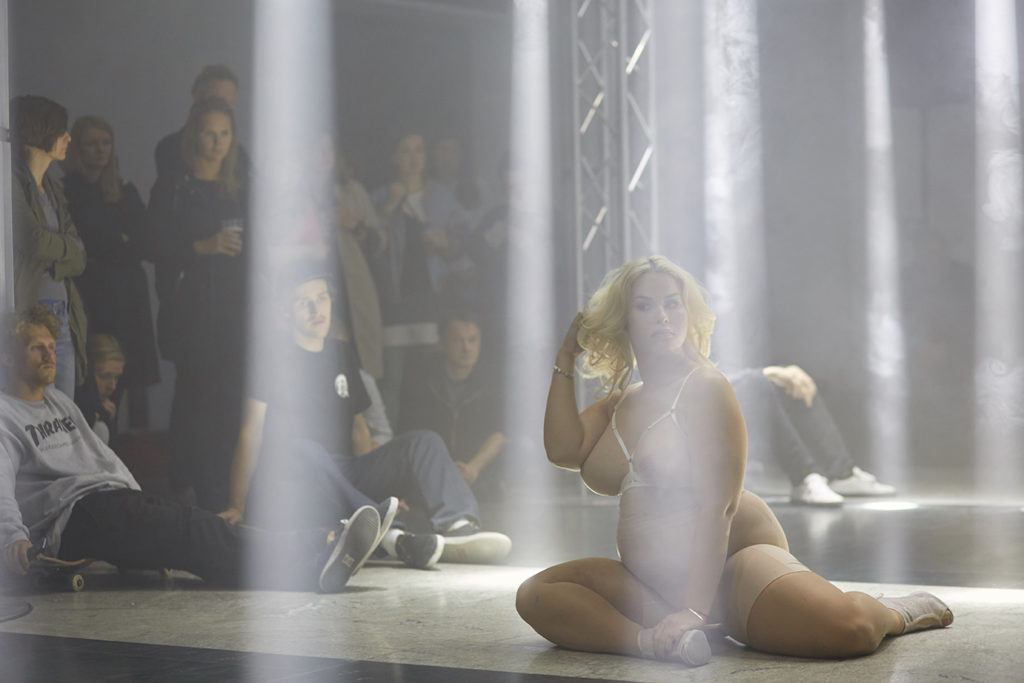
Wojciech Puś, The Endless Party, 2016, photo Jakub Ceran
DB: Your film is an action in process. On the one hand, there is the film set, on the other – a performance, which can be action per se. The Endless Party, a three-day event that you organized at the Palace of Culture and Science within the framework of the Warsaw Gallery Weekend 2016, was part of the set too.
WP: I organized a multi-day performance/party, a highly inclusive situation, for everyone could come in from the street and join us. It was the first time I directed and choreographed a performative situation. My actors, Magda Wawrzyńczak and Szymon Czacki, were joined by 10 young skateboarders who spread like a virus around the space, imitating gestures of loneliness, defense, and desolation that I’d selected from Last Year at Marienbad. The angelic, androgynous Pat Dudek performed Lana Del Rey’s The Blackest Day as a beautiful intro for the performance. Through that monumental gesture of fuzzy boundaries – blending performance, film set, theater, event, and site-specific installation – I had fulfilled my dream of queer abstraction. I filmed the whole thing in cinema quality. On each evening, my friend, composer Stefan Węgłowski, played his highly moving set, “Music for Nature and Industrial Sounds.” As a whole, the event ventured into many different regions that I construe as a party. It evolved for 50 hours, dying and rising again.
DB: The performance / party / film set open for everyone for almost three days and three nights. This means that it wasn’t “staged” 100%. Did it affect your work as a DOP?
WP: It sure did… I had to be open to many unusual situations, it was a big techno party! But I liked this unpredictable atmosphere of the ongoing performance… For many years now I was developing the idea of “the choreographic camera” and working as a DOP in a way that is very performative. It is not usual for the film industry, but you know… I always felt that way, like a performer. Now working on Endless I clearly see this idea works. It is unusual and fresh and it’s not popular… It’s also quite physically exhausting, but camera is a choreographic tool for me.
DB: Endless Party was another step in the work-in-progress. The next one is scheduled to start in the few months.
WP: The material we shot last summer and in September is still test footage. In March I’ll be looking for locations and in April we’re going to be test-shooting realistic scenes inspired by excerpts from Beatriz Praciado’s book.
DB: Tell me more about the film. You recently showed a test fragment of it in Florence as part of another stretch of your artistic residency.
WP: Several years ago I met the film’s protagonist, Magda, who was then called Piotr, and started watching her metamorphosis, which has been a most beautiful thing. I know now that it has also been very painful in the reality that we live in. Meeting Magda became an impulse for imagining a film that would deal with the theme of sex reassignment or, as it is more aptly called, gender confirmation. The latter term is not so much politically correct as more affirmative of the change that is taking place. Even more recent terminology speaks of gender fluidity and morphing. A year and a half ago Natalia Sielewicz from the Museum of Modern Art in Warsaw told me they were planning a queer exhibition there. The project floundered, but meeting Natalia was a true inspiration. I started thinking of making a film about a morphing character, about someone who is in some sense excluded, though not specifically because of their sexuality but rather because of some vague maladjustment. A character that is always strange and situated on the threshold, neither here nor there – in between. One that exists in a kind of limbo, in no particular reality completely. Then I met Magda again, who was already past surgery. I was absolutely stunned by her crazy Nicki Minaj x Baroque persona. The meeting was moving, opening, one of a kind. Magda’s life and biography became the foundation of the Endless project. She also provided me with the title when she told me that her transition would “go on without end.” Magda will play the afterimage of herself in the movie.

Wojciech Puś, Endless, 2016
DB: And the Marienbad theme?
WP: For many years I’ve been showing to my students Alain Resnais’s L’Année dernière à Marienbad, based on a script by Alain Robbe-Grillet. And precisely a year and a half ago, when I’d played the film again in my class, all the fragments of the puzzle suddenly clicked together. The story that Resnais tells is incredibly sexist and heteronormative. Just look at how the heroine is shown – as an object, a pretty thing, like a piece of fine furniture: a fulfillment of male heterosexual fantasies. And I suddenly realized that that was the interesting thing, not the film itself, but a whole literary level that distorts our perception. All the time we don’t know whether we are inside the mind, or a dream, of a heterosexual male, or in a woman’s nightmare. We don’t know where we are. The main protagonist, who is a rather dumb fellow, lives an utterly unreal life, pursuing a goal he’ll never attain anyway. In Endless we have X and A, just like in Marienbad, but as a single morphing figure who is fighting an inner struggle. Both the film and the book that my script is based on perfectly reflect what happens to a transgender person and how their mind works during the transition, when the hormones take their effect. During my meetings with Magda, I observed her reactions to the medicines she took, the hormones. She told me how her perception of the world was changing, and she meant literally: her sense of smell, sight, touch – everything! It’s like a filter on reality. Beatriz Preciado (as Paul Preciado was still known at the time of writing his book) describes craving for testosterone as if it was a narcotic, hence the “junkie” in the title. Those motifs just clicked together. I was very keen to work again with Szymon Czacki, who many years ago had appeared in my film, Instant. Magda and Szymon met and it was the love at first sight, so cool! We decided that it would be Szymon who would play X – Magda pre-change. He is an incredibly sensitive, remarkably talented and intelligent artist. One of my favorite polish actresses, Katarzyna Warnke would play A: Magda after transition. Josef Ostendorf, one of the best german actors, who played in many Christoph Marthaler’s and Frank Castorf’s pieces, agreed to play M – A’s lover. It is an honor to work with him. He is a true friend and he’s fun to be with. And, you know, all my crew is insanely hot, you would die! [laughs]
DB: The film is also an extremely intimate account of the experiences of a transitioning person.
WP: And from their point of view. What seemed most interesting to me was their experience. Not the social and political aspects, you know – the reactions of co-workers, family members, friends…Those stories have already been told! What I’d like to do is show the world through the eyes of a person who is undergoing an immense transformation – and finally, one should add. This film will be a new voice, one completely different from anything that’s been said on the subject of transgender identity in international feature film so far.
DB: Its point of departure and arrival is the individual – the protagonist. In fact, in all your projects the narrative revolves around emotions, thoughts, and fantasies, and an image of the outside world is constructed through a private story, often your own.
WB: It’s a bit different, though, in Endless because I tell stories from Magda’s life.
DB: And it is her who is the beginning and the end of the represented world – a point of reference for the story.
WP: It cannot be otherwise.

Wojciech Puś, Magic Hour, 2013

Wojciech Puś, Magic Hour, 2013
DB: Your works oscillate closely around abstract notions and phenomena such as intimacy, delicateness, or corporeality, as evidenced, for example, by your Magic Hour where in one of the scenes the protagonist comes out of water and it envelops him, a transparent film, shiny and liquid, as if it were his second skin – an incredibly erotic scene. Plus there is sound, which accompanies all your projects – so another highly ephemeral language. Then there is light and your light installations. We enter the territory of abstract statements that can function as pure images, to produce which you actually often use cutting-edge technologies.
WP: When I think of the latest issue of your magazine, which I had the pleasure to contribute to, and the main theme of which are new technologies and their artistic uses, I am reminded of my two most recent works, Magic Hour and A|N. In making them, I employed cutting-edge filmic technologies which until now have been used in laboratory conditions, to film, for example, a bullet penetrating ice at several thousand frames per second. I resorted to them because I wanted to capture the moment, the fleeting split second, to show its fleshiness and intensity, but also because I was fascinated by the fact that I could use a camera that would turn reality into a kind of filmic sculpture. I can use it in a documentary manner, for everything in Magic Hour is a documentation of phenomena and situations, there are no rehearsed scenes there, and the filming took three hours on one day and four on another. In A|N, I used a motion control crane, the movement of which can be programmed and controlled to a pixel so you can shoot scenes using exactly the same parameters. In that work, modern technology helped me to reference Oskar Hansen’s idea of the „active negative” by composing parallel scenes, with identical camera movement, distinguished only by the presence or absence of people.
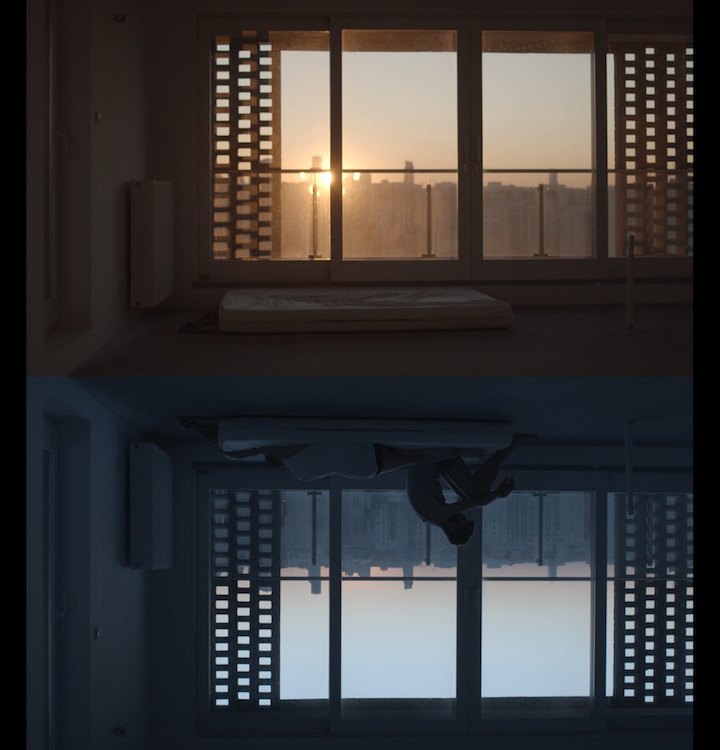
Wojciech Puś, A|N, 2015
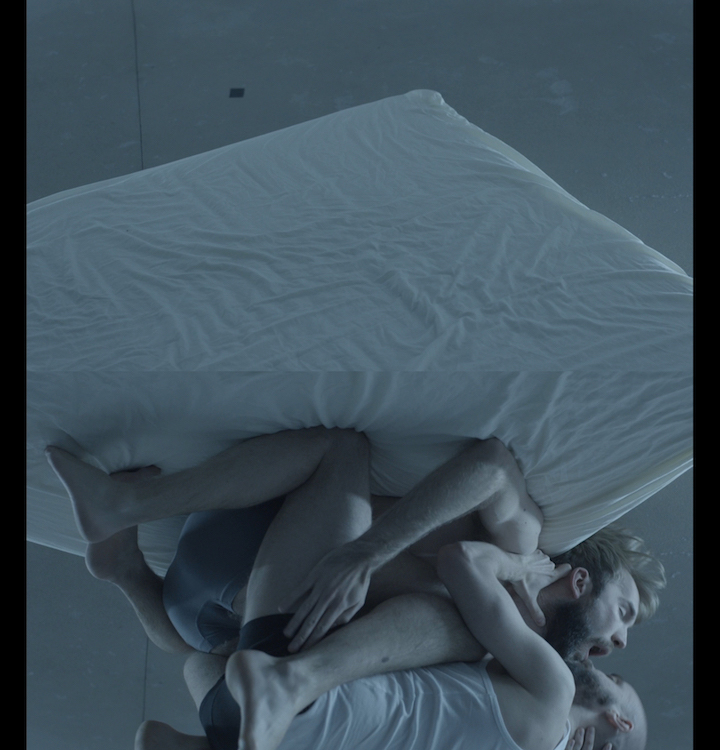
Wojciech Puś, A|N, 2015
DB: You also compose sounds, creating music for most of your exhibitions and films.
WP: “Compose” is too much of a word. When I was a kid I played piano for several years, so now I can improvise freely, and the effects can be found in many of my projects, including Magic Hour. Recently I use ROLI Seaboard which is a MIDI controller and an instrument to record my improvisations. I can use it in many creative ways as everything depends on how I touch it. It can be a wind instrument, a clavier, a string, it can play like a harp or be used as a pad – all that made possible by five touch recognition modes and a thick silicone layer that feels like a body. Playing it is a very sensual experience.
DB: But in your works the sounds are not necessarily generated by instruments. Sometimes they are recordings of real-life sounds, such as breathing.
WP: Ultimately, the breathing of the sleeping man sounded like voices carrying across an evening lake, reaching your years after some time and slightly mutated. In A|N, I recorded, and added to the perfectly generated screen reality, sounds from the set as I wanted for sound to be something totally distinct from and external to the visuals. Sound created a distance, showing a rupture through which a parallel world leaks in.
DB: It is also a kind of wink at the viewer… Watching the trailer of your latest film or thinking back to your previous works, I realize that their recurring motif is the creation of a self-image through moments, fragments of reality. Sometimes it is distorted, multiplied, blurry… The trembling one-way mirrors in the installation Better to Repeat Than to Think produced a new image of the person facing them, or rather hundreds of images that could be merged into one only in the mind of the spectator/protagonist of this exhibition and film in one. In all your projects you consistently pursue an image of yourself through external images. Hence the frequent motif of the mirror (also in our cover). We agreed earlier that you don’t comment on reality, but I think you actually do! Not directly, of course. You don’t offer any clear-cut answers or solutions, but by confronting the protagonist with themselves, you use an individual story to convey an image of society. Together these individual viewpoints yield a broader picture. On the other hand, no viewer can see it in its completeness and objectivity.
WP: And that makes it multidimensional. It’s a bit like with sexuality. We’re used to hetero versus homo, but in reality the number of possibilities is far greater. The aim of my work and my films is for everyone to see themselves truly, to see their own unique hue.
DB: In your works you offer precisely this possibility of consciously shaping oneself, the work, the exhibition. You create a situation rather than an isolated reality. These situations unfold in time and through the persons that confront them. So you focus on generating potentialities that play themselves out on the edge of the visible, in the “limbo” you mentioned before.
WP: The idea is exactly to leave things open, to avoid closed form, so that everyone can come up with their own interpretation. This sometimes manifests itself in funny ways. When I was showing Magic Hour in the exhibition As You Can See at the Museum of Modern Art in Warsaw, many people knew one of the scenes showed an ejaculation filmed at 1,000 frames per second. I met Józef Robakowski there, he was going out, and he told me, “You know, it’s really funny: a bunch of children are watching your film and what they find particularly appealing is the ‘water’ gushing in the air.” So five-year-olds could watch Magic Hour too.

Wojciech Puś, Magic Hour, 2013
DB: You filmed it like a sculpture, an object.
WP: I was fascinated at the time with ejaculation as an energy medium, with its youthful vitality, consistency, weight. I decided to film it as an abstraction. And in two ways: against the sky – that’s my naïve fascination – and against dark greenery – that’s my fear of AIDS.
DB: This bipolarity can often be found in your work, and light plays an important role in emphasizing it. A beautiful sunset is very romantic, but it also carries the threat of the end (of day), of disappearance.
WP: I grew up in the countryside, close to nature, and I saw its various aspects: cruelty coinciding with beauty. A sense of impending doom accompanies all my works. As much as a sense of constant change.
DB: In Endless, change goes hand in hand with great anxiety. It is a struggle for oneself, but also with oneself, with one’s own organism, and you don’t know how it’s ultimately going to affect you.
WP: Many scenes in the script have been directly inspired by real-life events. The killings of trans people in the US, Brazil, but also Poland. It’s something that’s been completely ignored by the media, and we want to say as much in the film. The script includes several powerful scenes related directly to events in Magda’s life, which are reflected in the mirror of Last Year at Marienbad and Testo Junkie. We play with the political here, but I’m more interested in exploring the subject of blind, mean evil. It is most dangerous and will always survive. But I know that this freak of mine, whom society rejects, will be revived. And – thanks to films such as Endless – revived stronger and more effective. In recent months I’ve received lots of support and great energy from many sides. I’m surrounded by good people. That’s why I believe, and know, that we’ll succeed.
Translated by Marcin Wawrzyńczak
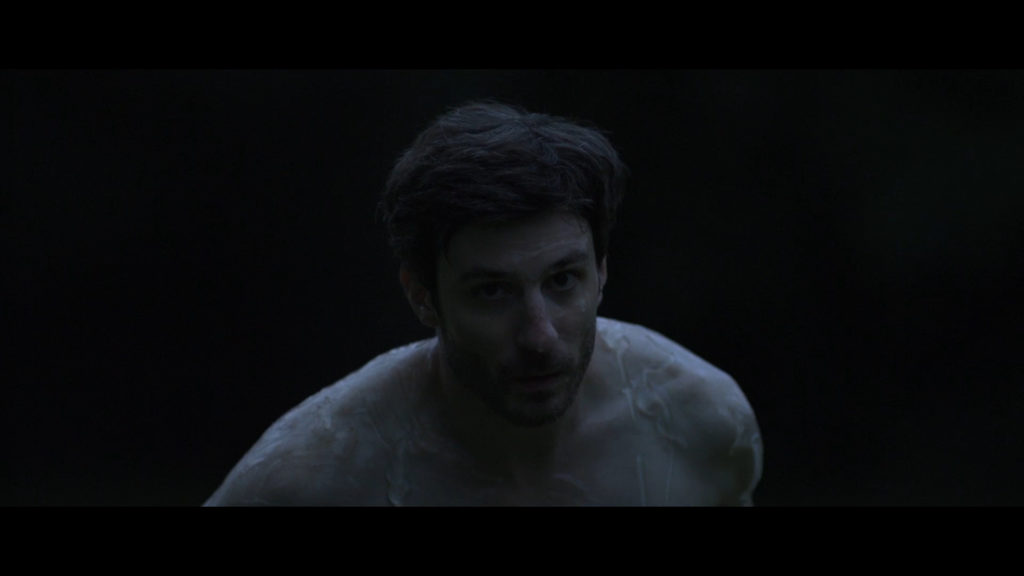
Wojciech Puś, Endless, 2016.

Wojciech Puś, Endless , 2016.












